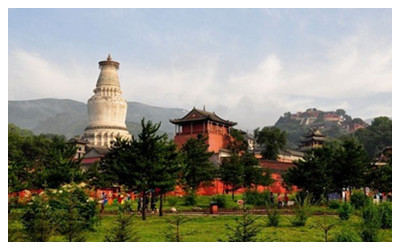
Wutai Mountain, known as the most holy land of Chinese Buddhism, is rated on both the list of the first group of national scenic spots designated by the State Council, and the list of the Top 10 scenic spots in Shanxi Province. It is as famous as Mt. Emei in Sichuan Province, Mount Putuo in Zhejiang Province, and Mount Jiuhua in Anhui Province, all of which are renowned as the four sacred Buddhist Mountains.
Five Peaks of Wutai MountainThe five main peaks of Wutai Mountain, positioned east, south, west, north, and in the middle, embrace one another with broad and plain terraces rather than forests on their tops. That is why it bears the name "Wutai Shan" (Mountain of Five Terraces). The summit of the northern peak which is famed as being the "Roof of Northern China", reaches 3061.1 meters. Besides the religious aspect, the beauty of rising and falling ridges of mountains, exotic rocks, crisscrossed gullies, crystalline waters and towering green forests also gives the mountain its reputation as a colorful and notable scenic resort.
The beautiful scenery in Wutai Mountain is a masterpiece of exquisite acts of nature, predominantly visible over the five main peaks: Wanghai Peak in the east, Guayue Peak in the west, Jinxiu Peak in the south, Yedou Peak in the north, and the central Cuiyan Peak.
Wutai Mountain Temples
It is said that Mount Wutai is the dwelling place of Manjusri Bodhisattva. 360 temples were built here dating back to the Tang Dynasty (618-907) but now only 47 of them exist. Over the years, incalculable numbers of pilgrims and visitors have come here. Among these magnificent temples, five are the most famous: Xiantong Temple, TayuanTemple, Manjusri Temple (Summit Bodhisattva), Shuxiang Temple, and Luohou Temple.
Other Resources
Shancai Cave Mount Wutai is resplendent in many resources owing to its natural conditions and important role in Buddhism.
Over 600 species of plants can be found, of which more than 150 species of grass can be used as rare herbs. Special local produce, Taimo, (mushrooms grown on the tops of peaks of Mount Wutai) is of quite high nutritional value and with a delicate taste.
Since many temples are interspersed in Mount Wutai, numerous art works were cared for and have been preserved as relics-sculptures, murals, calligraphy, as well as architecture. Pagodas built in the style of those in ancient India added new types to traditional ones. Nanchan Temple and Foguang Temple, built in the Tang Dynasty, are representatives of the ancient wooden style of construction, and have the longest history amongst the temples in the mountain.
Mount Wutai was included in 1982 by the State Council in the first tier of national level scenic areas. Over the years, its standing and reputation have grown and it is now regarded as a national key scenic area, national geological park, national natural and cultural heritage location, and national 5A tourism scenic spot. Mount Wutai was added to UNESCO's World Heritage List in 2009.
Travel Tips
Add: in Wutai County in Xinzhou Region, Shanxi Province
http://wts.sxxz.gov.cn/
Area: 2,837 square kilometers (1,095.4 square miles)
Average Altitude: 1,000 meters (over 3,281 feet)
Entrance Fees: CNY135
Cable car of Dailuo Peak: CNY 50 (one-way); CNY 80 (round-trip)
Cable car of Fomu Cave: CNY 50 (one-way); CNY 85 (round-trip)
Opening Hours: :08:00-17:00
 Wutai Mountain, known as the most holy land of Chinese Buddhism, is rated on both the list of the first group of national scenic spots designated by the State Council, and the list of the Top 10 scenic spots in Shanxi Province. It is as famous as Mt. Emei in Sichuan Province, Mount Putuo in Zhejiang Province, and Mount Jiuhua in Anhui Province, all of which are renowned as the four sacred Buddhist Mountains.
Wutai Mountain, known as the most holy land of Chinese Buddhism, is rated on both the list of the first group of national scenic spots designated by the State Council, and the list of the Top 10 scenic spots in Shanxi Province. It is as famous as Mt. Emei in Sichuan Province, Mount Putuo in Zhejiang Province, and Mount Jiuhua in Anhui Province, all of which are renowned as the four sacred Buddhist Mountains.  Ask Questions ?
Ask Questions ?